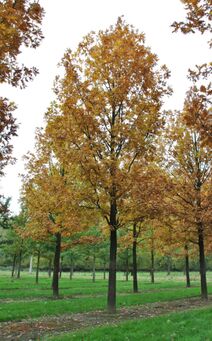Quercus frainetto
| Quercus frainetto | |
 | |
| Light: | |
| Moisture: | |
| Hardiness: | 6 |
| Soil pH: | 5.6-8.4 |
| Height: | 98' |
| Open Woods Forest | |
| Native to: | |
| Edible Rating: | |
| Medicinal Rating: | |
| Tea: | Yes |
Quercus frainetto (common name: hungarian oak)
Propagation: Seed - it quickly loses viability if it is allowed to dry out. It can be stored moist and cool overwinter but is best sown as soon as it is ripe in an outdoor seed bed, though it must be protected from mice, squirrels etc. Small quantities of seed can be sown in deep pots in a cold frame. Plants produce a deep taproot and need to be planted out into their permanent positions as soon as possible, in fact seed sown in situ will produce the best trees[1]. Trees should not be left in a nursery bed for more than 2 growing seasons without being moved or they will transplant very badly.
Cultivation: Prefers a good deep fertile loam which can be on the stiff side[2][1]. Young plants tolerate reasonable levels of side shade[3]. Tolerates moderate exposure, surviving well but being somewhat stunted[3].
This species thrives in Britain, despite our cooler summers, but it only bears acorns occasionally[1]. The acorns ripen in their first year[3].
Intolerant of root disturbance, trees should be planted in their permanent positions whilst young[1].
Hybridizes freely with other members of the genus[3].
Plants in this genus are notably resistant to honey fungus[3].
Range: Europe - Hungary, S. Italy and the Balkans.
Edibility: Seed - raw or cooked. The seed is up to 3.5cm long and 1.2cm wide[3]. It can be dried, ground into a powder and used as a thickening in stews etc or mixed with cereals for making bread[4]. If the seed contains bitter tannins, these can be leached out by thoroughly washing the seed in running water though many minerals will also be lost. Either the whole seed can be used or the seed can be dried and ground it into a powder. It can take several days or even weeks to properly leach whole seeds, one method was to wrap them in a cloth bag and place them in a stream. Leaching the powder is quicker. A simple taste test can tell when the tannin has been leached. The traditional method of preparing the seed was to bury it in boggy ground overwinter. The germinating seed was dug up in the spring when it would have lost most of its astringency.
The roasted seed is a coffee substitute.
Medicinal: Any galls produced on the tree are strongly astringent and can be used in the treatment of haemorrhages, chronic diarrhoea, dysentery etc[5].
Usage: A mulch of the leaves repels slugs, grubs etc, though fresh leaves should not be used as these can inhibit plant growth[6].
The seed cups are used as buttons[7].
The bark is a commercial source of tannin[8][9]. Tannin is also found in the leaves and wood[9].
Oak galls are excrescences that are sometimes produced in great numbers on the tree and are caused by the activity of the larvae of different insects. The insects live inside these galls, obtaining their nutrient therein. When the insect pupates and leaves, the gall can be used as a rich source of tannin, that can also be used as a dyestuff[5].
Pollinators: Wind
Soil: Can grow in medium and heavy soils.
Wind: Tolerates strong winds
Flower Type: Monoecious
Also Known As: Q. conferta. Kit.
Links
References
- ↑ 1.0 1.1 1.2 1.3 Bean, William. Trees and Shrubs Hardy in Great Britain. Murray, 1981.
- ↑ Chittendon, Fred. RHS Dictionary of Plants. Oxford University Press, 1951.
- ↑ 3.0 3.1 3.2 3.3 3.4 3.5 Huxley, Anthony. The New Royal Horticultural Society Dictionary of Gardening. MacMillan Press, 1992.
- ↑ Facciola, Stephen. Cornucopia - A Source Book of Edible Plants. Kampong Publications, 1990.
- ↑ 5.0 5.1 Grieve, Margaret. A Modern Herbal. Penguin, 1984.
- ↑ Riotte, Louise. Carrots Love Tomatoes. Garden Way, 1978.
- ↑ Saunders, Charles. Edible and Useful Wild Plants of the United States and Canada. Dover Publications, 1976.
- ↑ Uphof, Johannes. Dictionary of Economic Plants. Weinheim, 1959.
- ↑ 9.0 9.1 Rottsieper, E. Vegetable Tannins. The Forestal Land, 1946.